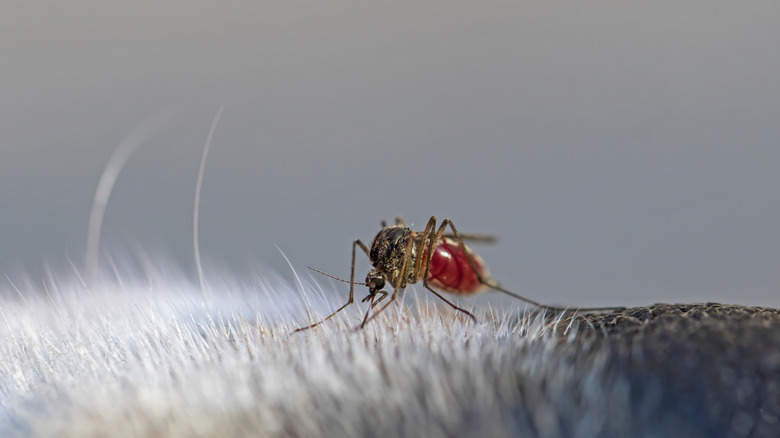Bugs That Pose The Biggest Risk To Your Pets Outdoors
We all wish our pets were invincible to dangers, but sometimes it's the tiniest creatures, like bugs, that pose the greatest threats. Certain bugs can lead to unpleasant symptoms or health problems in dogs, cats, and other animals. Some of these reactions can occur within the same day of contact, while others develop gradually over time. In some cases, insect-related conditions can require expensive treatment or even be fatal. Five insects that pose the biggest risk to your pets outdoors include fleas, mosquitoes, ticks, fire ants, and bees.
The good news is that there are numerous ways you can take preventive measures to shield your canine or feline companion from most of these insects. You can purchase topical, oral, or collar parasite preventives either from your veterinarian or over the counter. Some products provide protection for up to eight months while others last only one month. As an added convenience, many products protect against multiple pests, so you won't have to buy one preventative for each one.
If your pet spends a lot of time outdoors, they are more at risk for coming in contact with parasites and other bugs. However, even pets that spend most of their lives indoors could still be exposed. This is why it's so important to establish a preventive treatment plan. Your veterinarian can provide recommendations based on your pet's lifestyle and your personal preferences.
Fleas
Barely visible with the naked eye, fleas prefer areas with high grass, warmth, shade, and high moisture. Many yards serve as the perfect environment for these pesky critters, especially in the summer. They pose a threat to mammals (including humans) because they feed on their blood, which is their only food source. They multiply quickly with the ability to lay 50 eggs in one day on the fur of their host. They're also excellent jumpers, making them difficult to completely eradicate from a home.
One flea can consume up to 15 blood meals within a 24-hour period, all of which can come from one pet. Their bites can cause bothersome itching and scratching. If your pet is allergic to flea bites, they can develop flea allergy dermatitis (FAD) and end up excessively chewing and scratching, leading to hair loss, skin problems, and infections that require veterinary care. These tiny bloodsuckers can also cause tapeworms that end up in a pet's stool.
If your home is infested (flea dirt is an indicator of an infestation), it likely means that multiple fleas are feeding on your fur baby throughout the day and night. Over time, the loss of red blood cells in the host can lead to anemia, causing lethargy, a rapid pulse, weight loss, and facial swelling. In severe cases, anemia can be fatal.
Mosquitoes
Mosquitoes — specifically female mosquitoes — are similar to fleas in that they, too, feed on the blood of animals. They also prefer a similar habitat of tall grass, water, shade, humidity, and warmth. Unlike fleas, though, mosquitoes lay their eggs in water, not in an animal's fur. They also don't live on pets, but on a wet, sticky, summer night, it's possible to see a dozen or more mosquitoes trying to get their next meal from your dog or cat.
A mosquito bite on a canine or feline is similar to one on a human; it causes inflammation and redness at the site as well as itching. However, if a mosquito that's infected with heartworm larvae bites your pet, it can transfer the larvae via your pet's bloodstream. The larvae eventually migrate to the heart, where they grow, multiply, and cause blockage. This condition is known as heartworm disease, and without treatment, it can be deadly.
Fortunately, not all mosquitoes carry heartworm larvae. In fact, only certain species are even capable of transmitting worms to their hosts. As another sigh of relief, not every state in the U.S. sees the same average number of heartworm cases. According to American Heartworm Society President Dr. Jennifer Rizzo, DVM, "The states with the highest density of diagnosed heartworm cases in the latest survey were Mississippi, Louisiana, Texas, Alabama, and Arkansas." However, cases have been reported in all 50 states.
Ticks
The third critter on the list is yet another parasite, the tick. Technically, ticks are arachnids, not insects, because they have eight legs. Ticks thrive in wooded, shrubby, or grassy areas, so your pet is more likely to encounter one during a walk through a forest than in a well-maintained back lawn. Unlike mosquitoes and fleas, ticks don't jump or fly. Unfortunately, though, it only takes one tick to pose a threat to your pet.
When a tick finds a host, it attaches itself to the skin with its hooks to feed from it. As it ingests its blood meal, it becomes engorged and appears as an oval-shaped pea. The most common risk associated with ticks is Lyme disease, a bacterial infection that causes fever, inflamed and swollen joints, lethargy, loss of appetite, and swollen lymph nodes. Although cases of the disease have been reported in almost every state, it's most common in the northeastern states.
Another unique attribute of these arachnids is that you can't just grab, smack, or shoo one away to remove it from your pet. Once it's attached, you have to remove it slowly with a pair of sterilized tweezers, ensuring the head doesn't break off. If it does break off, removing a tick's head from a dog or cat can be done with the same pair of tweezers. Be sure to wear gloves during the removal process.
Fire ants
Some ant species are found in every state, but fire ants typically make their homes in the southeastern portion of the U.S. and a small portion of California. This invasive species poses a threat not just to animals but to the environment because they eat certain crops. Although they don't feed on pets, the danger to dogs and cats lies in the ants' stingers. These stingers inject venom into the skin, causing an uncomfortable or even painful burning sensation, hence the name "fire" ants.
One of the few positive attributes of fire ants is that they don't sting pets unless they feel threatened. You don't have to worry about them targeting or crawling on your pet for their dinner like you would with other pests. What causes fire ants to feel threatened? Disrupting their mounds, such as by stepping on them. If your pet were to walk on an active fire ant mound, it could result in hundreds of fire ants crawling out, biting and stinging along the way.
On a pet, a fire ant sting causes symptoms comparable to mosquito bites — itchiness and inflammation at the site — plus the aforementioned unpleasant burning sensation. A bite or two likely won't cause any other symptoms, so you can treat ant bites on a dog or cat from home. The venom from multiple bites and stings, however, could cause a severe allergic reaction, leading to breathing problems, unresponsiveness, and even seizures, requiring an emergency visit to the vet.
Bees
Bees fall in the same threat category as fire ants; they don't feed on animals, they sting. They also won't cause harm unless it's in an effort to defend themselves. Usually, if you don't bother them, they won't bother you. A curious canine or cat, however, could easily disrupt a hive, intentionally or unintentionally, and end up getting chased and stung by a swarm of angry bees.
A single bee sting on a dog or cat can likely be treated at home with tweezers, baking soda, and an ice pack, but speak with a veterinarian for advice. If you're unsure if a bee has stung your pet, look for signs like swelling, drooling, pawing at their face, and excessive licking at the bite site. Since a pet is most likely to encounter a bee with its nose or paws, these are the areas most likely to be stung.
Keep an eye on your pet after a confirmed or suspected bee sting, especially if multiple stings were involved, in case they have an allergic or anaphylactic reaction. Symptoms of an allergic reaction include facial swelling, diarrhea, vomiting, and weakness. If you see any of these symptoms, take your pet to a veterinarian ASAP for treatment.





